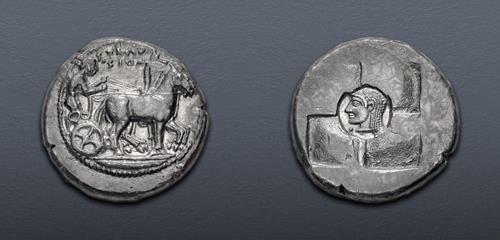|
SICILY, Syracuse. The Gamoroi. Circa 500-490/86 BC. AR Tetradrachm (25.5mm, 17.20 g, 5h). Charioteer, holding reins in both hands, driving slow quadriga right; SVRA(koppa)/SION in two lines above / Head of Arethousa left in incuse circle in center of quadripartite incuse square. Boehringer Series I, 10 (V8/R6); HGC 2, 1301 (same obv. die as illustration); SNG ANS 2 (same obv. die); SNG München 918 (same obv. die); Basel 421; Dewing 686; Gillet 524 (same dies); Kraay & Hirmer 72 (same rev. die); Kunstfreund 56 (same rev. die); Rizzo pl. XXXIV, 4–5. Deep find patina, light roughness. Near EF. Well centered.
The magnificent artistic flowering in Sicily in the 5th century BC, exemplified by the matchless coinage of Syracuse, originated in times of great strife. When the first colonists from Greece arrived on the fertile island in the 8th century BC, they found competitors in both the aboriginal inhabitants, the Sicels, Sicani, and Elymi, and the Phoenician colonists who established Carthage at about the same time. The social stresses set up by these conflicts prepared the way for the establishment of various tyrannies. Hippokrates of Gela was the first of the well known tyrants, and his son Gelon founded the greatest of the Sicilian courts at Syracuse in 485 BC. By the middle of the century, the situation began to resemble that of Renaissance Italy, where the princes engaged in continual warfare between themselves, while engaging the services of the finest artists and craftsmen of their time. Such fighting required significant amounts of money to hire mercenaries, and the increasing cultural sophistication of the courts encouraged experimentation in the all the arts, including the minor ones- the result was the patronizing of some of the most talented coin engravers in history.
In Syracuse and surrounding cities, the anonymous "Demareteion Master" and the "Maestro della foglia" were followed by their students and successors who proudly signed their work, such artists as Choirion, Euainetos, Eumenos, Exakestidas, Herakleidas, and others. These masters developed new ways of viewing the world through art, breaking the static forms of Classic art and developing new methods of portraying motion and life in miniature. The silver tetradrachm was the prefered mode of expression, being large enough for the expression free-ranging talents and also being minted in vast quantities to finance the expensive operations of the Greek hegemons. Even more remarkable were the large silver dekadrachms of Syracuse, which have become universal symbols of Greek numismatic art. Despite the emphasis on the great masterpieces, even the smallest of the silver fractions received the attentions of the masters, and the infrequent issues of gold likewise.
Syracuse commenced its silver coinage at the end of the sixth century BC with an issue of tetradrachms on the Attic standard of about 17.2 grams. These coins are attributed to the Gamoroi, an oligarchic body of aristocrats who battled outsiders, and each other, for control of civic and financial affairs. The obverse features charioteer driving a walking quadriga while the reverse originally bore an incuse square divided into four compartments, which quickly gave way to the design seen here, a swastika-pattern incuse with a circle at its center bearing a female head to left. This is certainly the nymph Arethousa, sacred to the spring of Ortygia which provided Syracuse its pure water. These designs set the paradigm for a century of Syracusan coinage, although the head of Arethousa would soon outgrow the confines of the small incuse circle to occupy most of the reverse, surrounded by frolicking dolphins.
The final winners of all Triton XXVII lots will be determined at the live public sale that will be held on 9-10 January 2024.
Triton XXVII – Session One – Lot 1-337 will be held Tuesday morning, 9 January 2024 beginning at 9:00 AM ET.
Winning bids are subject to a 22.5% buyer's fee for bids placed on this website and 25% for all others.
We recognize that our users may have various Internet Browsers and Operating Systems. We like our visitors to have the best possible experience when using our bidding platform. However, we do recognize that it is impossible to develop applications that work identically, efficiently and effectively on all web browsers. The CNG bidding platform supports the latest stable major version and stable previous version of Chrome and Firefox.
|
